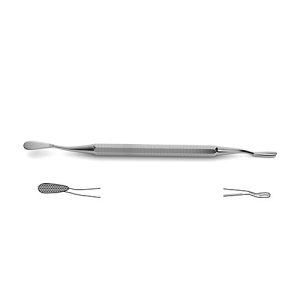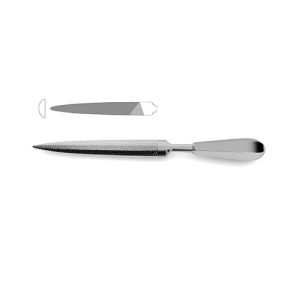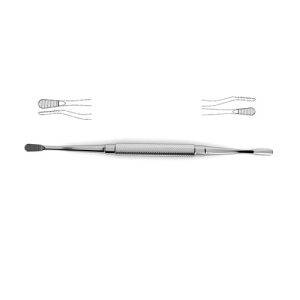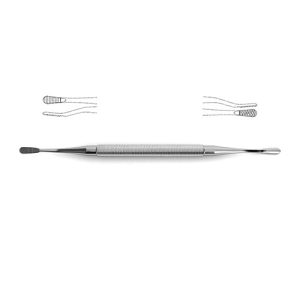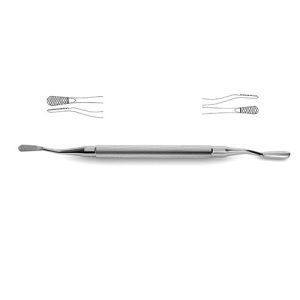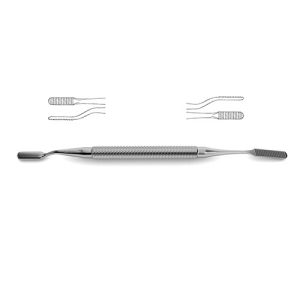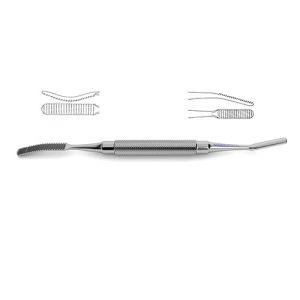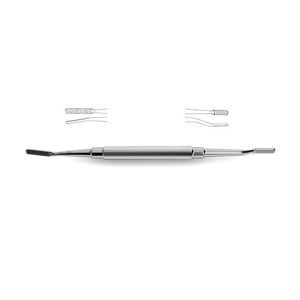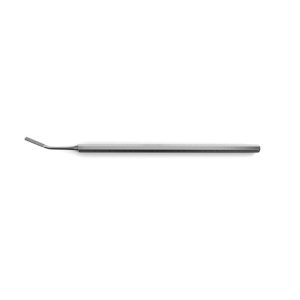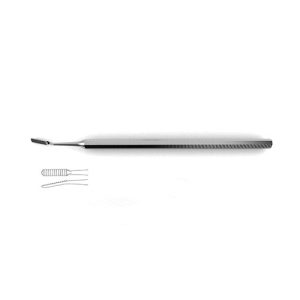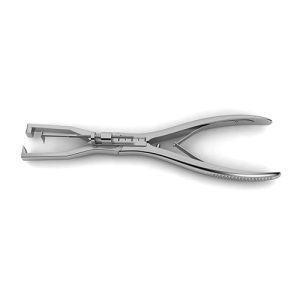SURGICAL INSTRUMENTS
Bone File – Double-Ended
double-ended, cross-cut, 7" (18.0 cm) Bone File is a highly versatile instrument that can be used in a vast array of surgical procedures. This file is double ended and is cross cut. The small paddle style blades allow it to be used near delicate tissue areas as are common in neurosurgical procedures and not cause trauma or injury by puncture wound. Additionally use of this file on jagged bone breaks or cuts or even on rough hard surfaces aids in the protected of neurovascular bundles and other tissue layers that are mobilized during surgery that can easily be torn or injured.
Bone File – Single-Ended
single-ended, 2-sided convex & flat blade, 23.0 mm width tapers to 6.0 mm, 11" (28.0 cm) Bone File is a ideally suited for many different surgical procedures. It is specifically designed to be used to file away at bone fragments that are caused by breaks or cuts or on coarse hard tissues in different parts of the body. They can be especially useful in neurosurgical and orthopedic procedures that can involve maneuvering and exploring around many different bony areas such as the skull, long bones and vertebral column. Additionally this file is single sided with a convex and flat blade and a 23.0 mm width that tapers to 6.0 mm.
Bone File #10
double-ended, plain serrations, 5.0 mm wide ends, 7" (17.5 cm) Bone File #10 is a general purpose instrument useful in surgical procedures that require manipulation of bone. This file is double ended making it quick and easy to switch to another unused file without having to switch instrumentation. Each end features plain serrations and is 5.0 mm wide. Additionally this instrument features a slightly textured handle surface that reduces slippage making this instrument ideally suited for a variety of precise neurosurgical procedures.
Bone File #12
double-ended, plain serrations, 7.0 mm & 5.0 mm wide ends, 7" (17.5 cm) Bone File #12 can be used in a variety of surgical interventions in neurosurgery or orthopedic surgery. This instrument is double ended with each end featuring plain serrations. It is ideally suited for use in filing bones such as reducing a sharp or jagged bone edge to prevent damage to surround tissue or delicate neuro-vascular bundles. Additionally each even here is a different width: 7.0 mm and 5.0 mm making it versatile enough to be used in a number of different surgical scenarios and can satisfy any surgeon preference.
Bone File #12A
double-ended, one end plain, other end cross serrated, 5.0 mm wide ends, 7" (17.5 cm) Bone File #12A is a highly versatile file that can be used in surgical procedures that require manipulation of bone. It is ideally suit for some forms of bone reshaping such as a jagged edge that could endanger the tissue areas around it. In procedures such as craniotomies in which delicate brain tissue is being handled this file aids in keeping the bony area around smooth and free of harmful points. Additionally this instrument is double ended with one end plain and the other cross serrated making it a multi functional file.
Bone File #12Ca
double-ended, bell pattern, cross serrations, 5.0 mm & 7.0 mm wide ends, 7" (17.5 cm) Bone File #12CA is designed for use in manipulation of bone. This particular file is designed in a bell pattern and is double-ended making it a versatile instrument that can be useful in a vast array of settings. One end is 5.0 mm while the other is 7.0 mm and both features cross serrations. This file can be useful in doing this such as filing down bone when doing grafting procedures or simply to reduce the jaggedness of bone and other hard protuberances that may cause trauma to surrounding soft tissue layers of vasculature.
Bone File #33
double-ended, plain serrations, 6.0 mm & 5.0 mm wide ends, 7" (17.5 cm) Bone File #33 is ideally suit for use in neurosurgical and orthopedic surgeries that require manipulation of bone in and around delicate tissue structures. This type of instrument can be useful in filing down the skull in procedures like craniotomies or in reshaping the vertebral arch during laminectomies or hemi-laminectomies. This gives added protection to the brain tissue or neurovascular bundles that can pass over these cut surfaces that may be jagged and could cause additionally injury or trauma. Additionally this file is double ended with plain serrations and features a 6.0 mm and 5.0 mm wide ends.
Bone File #45
double-ended, plain serrations, 6.0 mm & 5.0 mm wide ends, 7" (17.5 cm) Bone File #45 is an instrument crafted for use in neurosurgical orthopedic procedures. It features a hexagonal body that also serves as a grip that makes it easy to handle manually. This file is double ended and features plain serrations as well as two different sized ends: 6.0 mm and 5.0 mm. This instrument can be useful in surgical procedures that require filing or reshaping of bone particularly to prevent damage to surround tissue. Ideally it can be used to protect delicate brain tissue and neurovascular bundles from sharp jagged edges from breaks or from cuts made in surgery.
Bone File #64
double-ended, plain serrations, 3.0 mm & 4.0 mm wide, 7" (17.5 cm) Bone File #64 is a double ended instrument that can be used in a variety of surgical procedures. This file features plain serrations and can be used to smooth out sharp edges on bone during surgery. In surgeries where such delicate tissue is involved such as nerves, vessels or even brain tissue it is imperative to keep sharp surfaces from causing tear injuries. Additionally this instrument is comprised of premium German operating-room grade stainless steel.
Bone File #92A
single-ended, 2.0 mm wide, file outside, backward cutting, angled w/ serrations, 6" (15.0 cm) Bone File is a highly versatile instrument that can be used in almost any neurosurgical orthopedic procedures. Ranging from craniotomies to spinal surgery this file can be used to file down any types of bone. This can be useful in smoothing down rough edges to prevent catching or tearing of delicate tissues or vasculature during surgical intervention. This instrument is single-ended with the file outside and is angled with serrations and can be used in backward cutting.
Bone File #92B
single-ended, 2.0 mm wide, file inside, backward cutting, angled w/ serrations, 6" (15.0 cm) Bone File is a highly versatile instrument that can be used in almost any neurosurgical orthopedic procedures. Ranging from craniotomies to spinal surgery this file can be used to file down any types of bone. This can be useful in smoothing down rough edges to prevent catching or tearing of delicate tissues or vasculature during surgical intervention. This instrument is single-ended with the file inside and is angled with serrations and can be used in backward cutting.
Bone Graft Harvesting Forceps (Graft Cutter)
Bone Graft Harvesting Forceps (Graft Cutter)
adjustable depth control, 8-3/4" (22.0 cm)Bone Graft Harvesting Forceps are designed for use in orthopedic bone grafting procedures. These forceps are designed to harvest portions of bone for use in grafts in other parts of the body or even for use in a different patient. This instrument is also referred to as a graft cutter and comes equipped with an adjustable depth control. These forceps are available either 10.0 mm wide making it appropriate for 9.0 – 12.0 mm grafts or 7.0 mm wide making it appropriate for 6.0 – 9.0 mm grafts.




